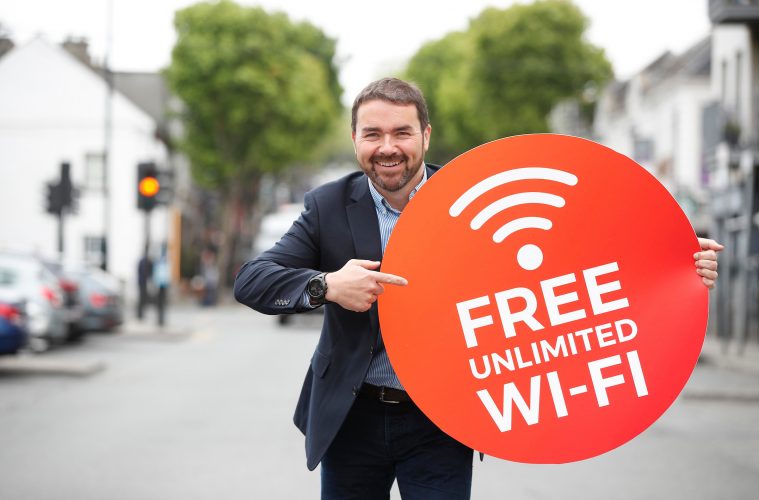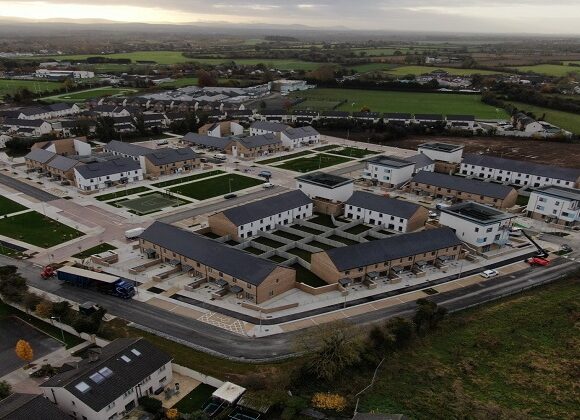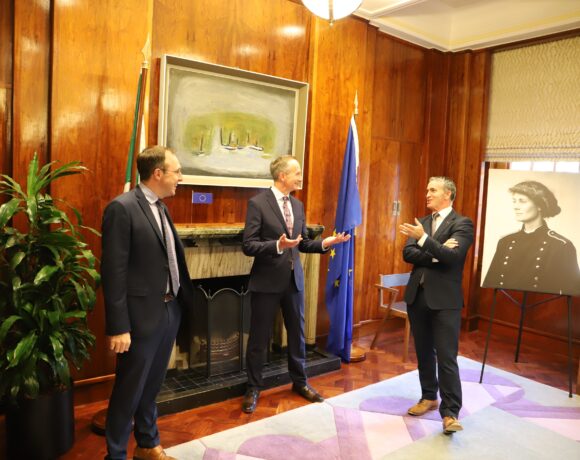CEO of Magnet Networks, Mark Kellett says he hopes to have 25 additional towns introduced to free and unlimited wi-fi by the end of the year.
It is the aspirations of Mark Kellett, CEO of Magnet Networks and of his company to install unlimited free wi-fi to 25 town centres across Ireland by the end of 2018.
At the beginning of June news emerged of a new initiative to implement free wi-fi zones to seven town centres across Ireland. Carrick-On-Shannon in Co Leitrim was the first out of the seven town centres to have wi-fi installed with speeds of up to 100mps. It should be noted that the scheme costs local towns nothing at all.
The same initiative is being rolled out in Sligo, Knock and Monaghan throughout the month of June, with Westport, Kerry and Donegal set to go live by August.
“There’s an initial list you saw but I am roadmapping deployments out through to the end of this year countrywide. For me the personal ambition and for the business ambition should be 25 towns, minimum,” Mark Kellett told Council Journal.
Mr Kellett has said the response in relation to the initiative has been “tremendous” and that county councils are approaching Magnet Networks to find out how they can take full advantage of this scheme and how they can engage with it also.
“We’ve had a lot of enquiries coming through from councils and locals which is how can we avail of this service, we want this for our town, can we avail of it. There is a demand for it.”
The idea for expanding stemmed from the pilot project which was brought to Galway city centre over a year ago. Mr Kellett also disclosed that Ballymun was an “early testbed” for free wi-fi that was brought in quietly.
A year on the initiative in Galway has been “very well received” from both the local community and tourists alike.
“We’ve also been using it to look at the types of people using it. A lot of tourists are using it, automatically through default. They come off the train, walk down Eyre Square and Shop Street and they’re looking for if there’s any free wi-fi available.
“What’s interesting to watch in the tourism sector, people instinctively look for where can I access and how can I use my app, whether it’s mapping etc, so that’s one experience.”
Motivation Behind The Initiative
The driving force behind the initiative was a consideration of the needs of the digitally disenfranchised.
Living in North County Wexford, Kellett understands the challenges faced in rural towns and down the country of not living off the standard connectivity platforms in an ever growing digital presence worldwide.
“You see the impact of the failure of the National Broadband Plan. You see how some towns, the main street has almost become emptied out. What’s drawing people in, what keeps people within the town and how are businesses being supported?
“There’s an element of the digitally disenfranchised which is real from a national rural perspective.
“The motivations are a personal understanding from myself, as a professional and knowing the industry.
“We also have our personal experiences internationally. Magnet Networks are doing very large scale wi-fi deployments in places like London and beyond.
“We’ve had a massive project for a number of years in Wembley Stadium, so when you have an NFL game going on you have 100,000 people accessing our wi-fi. The logic was if we can do it there then why can’t we do it in Ireland, so bringing it back home.”
Council Journal’s full Q&A with Mark Kellett can be viewed below:
Q What provided the motivation to create this initiative?
“The motivation of the digitally disconnected, the digitally disenfranchised. I’ve lived internationally, I’ve lived in Dublin, I’ve lived in towns and I’ve lived down in North Wexford.
“You see the impact of the failure of the National Broadband Plan. You see how some towns, the main street has almost become emptied out. What’s drawing people in, what keeps people within the town and how are businesses being supported?
“There’s an element of the digitally disenfranchised which is real from a national rural perspective. I live in North County Wexford so I know what it’s like to be living off the standard connectivity platforms. I’m not connected from a fixed or fibre cable perspective so I understand those challenges of trying to execute and live in that context.
“I’ve a background myself, being, I was the president of the Chambers of Commerce. I spent a lot of time around the country delivering presentations and events to Limerick, Galway, Waterford etc. You get a good sense of being out on the ground and open to local businesses and what the challenges are.
“The motivations are a personal understanding from myself, as a professional and knowing the industry, seeing how long it’s going to take to deploy goods and advance infrastructure. We also have our personal experiences internationally.
“Magnet Networks are doing very large scale wi-fi deployments in places like London and beyond. We’ve had a massive project for a number of years in Wembley Stadium, so when you have an NFL game going on you have 100,000 people accessing our wi-fi. The logic was if we can do it there then why can’t we do it in Ireland, so bringing it back home.
Could you tell us about the free public wi-fi initiative planned for seven towns across Ireland?
“The plan is actually much more pervasive. There has been a tremendous response and our expectations and my expectations would be within or deploying beyond 25 towns across the country.
“We already have requests and we’ve mapped out significantly beyond that initial list that you’ve seen. We’re in conversations across the country, in particular, with town councils. The councils will phone up and say how can we take advantage of this, what is it we can we do to engage on this.
“Separately I’m talking to other people in commercial space on how they could come on board and possibly assist, as well as academia, with all the various Institutes of Technology, here is a great platform for Irish businesses to deploy services.
“The EU has an initiative going on, separately, looking at how else we could fund this model. Part of the story that was talked about was the Wild Atlantic Way angle and tourists. It’s not just tourists. Anybody connecting on to this network, if they’re on business for example, can be connected anywhere around the town that has this wi-fi platform.
“You don’t need to log back in again. If, for example, you’re running a market in the town and one of the challenges we’ve seen is people running stall holders and food markets, etc which typically only operate with cash. With this wi-fi platform people can have a secure payments platform where they can connect handheld contactless payment devices on our network.
“It can possibly change the way town markets are worked, does it mean tourists have more, they can use a tap and go type payment in a local marketplace. The type of goods that can be sold which we’ve seen in the UK, one you have a marketplace and people only have cash, there’s no contactless payment.
“They’ll typically only sell low value items. If you suddenly change it to that you can use a contactless card to pay for things and, we see this at like an NFL game or MTV Awards, the amount people can spend in a market can grow significantly.
“I would be disappointed if we were not country wide with at least 25 sites by the end of the year, early into next year.”
What impact will this have on the towns themselves? What will the benefits be?
“The benefits are for the town. If you are in the town you are challenged with, as a small business, some connectivity or offering services to clients. On of the simple things and how you relate this down, the small coffee shop owner or someone with a street side cafe or a bar or restaurant, an important concept in that kind of industry is dwell time.
“How long people will sit and maybe not just buy one coffee or two, they might buy a sandwich and have lunch. A lot of people are sitting there on their device and they’re able to read the news or watch some content or Whatsapp eachother.
“We’ve seen it in other markets where initially people will grab a coffee and go. If there is facilities in the town like free wi-fi they will dwell longer because they are more consumed by being able to sit back and read the news, that’s an example of how it could apply at the lower end of the hospitality sector.
“Then you’re getting into other things like markets, people can access secure payment platforms. The town themselves, and this is an important one, people hear the phrase Big Data and analytics, what we’re able to map and track and provide to the councils is the flow of people in and around the town.
“So what building do people start off at in the morning? Where do people walk? Where are the traffic flows? As you have wi-fi around the town, you’re able to monitor a heat map which shows the densities of where people dwell and congregate. Now is that useful for the councils in terms of planning, parking planning, or think about if you’re trying to deliver services in terms of street cleaning, well where are the people congregating at lunchtime, where are they congregating at night-time.
“At 12 o’clock where do you see the congregation of after pub dwellers going, what are they doing? That kind of analysis allows you to, from a council standpoint, to think about services, parking etc. It allows businesses for the opportunity to advertise their own services.
“In some respects, if you said it was Ireland’s Ancient East or the Wild Atlantic Way, if I’m in Ballyshannon or Westport, you’re able to advertise to people who are on that Wild Atlantic Way, from a tourism perspective, services available in the next town. Do you want to advertise if there is an event on, is there a fleadh on etc in the next town you’re going to.
“There’s a range of opportunities that towns and council’s can grab in terms of commercial. In terms of engaging with schools and academia, you could give the Transition year students in a particular town the opportunity to manage the web page for that town, the Whatsapp, there’s a way of trying to develop digital skills for the schools in that town and give them real world experience. This opens up a range of opportunities, not just here’s some wi-fi, watch a video, but here’s a platform that can be used for a range of commercial development activities in a town.”
And when tourists connect to this wi-fi are there going to be some links to redirect them to the likes of small businesses or suggestions and recommendations?
“Put it like this, we’ve been doing this in Galway for a number of years, when you have the Galway Food Festival or you’re looking at businesses in the Square you can advertise, inform visitors about what’s on.
“You can change the landing page. For argument’s sake, if Sligo was going to have a fleadh on or if there was some other event on in the town, for that weekend you can change the landing page to information from the council about parking information, health and safety information, event times.
“That can be dynamically changed by the council or if you had a group of students in Sligo IT, or TY students being fed that information and being able to change it. It allows businesses to advertise themselves.
“There’s ways in which that information, the site can be adapted by certain times of the day, by 9 o’clock in the morning, you can have certain content after 5 in the evening after weekends, you can put up different types of content on the wi-fi landing pages.”
The initiative all stemmed from a pilot project in Galway, correct? A year on, what has the feedback been like in Galway? How has this benefitted the town?
“In terms of feedback, you’ve Galway, Ballymun is another project we’ve done, we brought free wi-fi in quietly, that was actually one of the early testbeds. Galway reached down Shop Street down to the Spanish Arch back into Eyre Square. That has grown and has been very well received from the business community.
“We’ve also been using it to look at the types of people using it. A lot of tourists are using it, automatically through default. They come off the train, walk down Eyre Square and Shop Street and they’re looking for is there any free wi-fi available.
“What’s interesting to watch in the tourism sector, people instinctively look for where can I access and how can I use my app, whether it’s mapping etc, so that’s one experience. One of the local food retailers on Shop Street, had asked the question, they only open at a certain time on a Sunday and they asked the question, from what we can see about footfall along Shop Street, as in people moving up and down by time of day, does it make sense for me to open at 12 o’clock or 11 o’clock?
“Currently this person opens at 1 o’clock and sells coffees, teas, etc and we said well actually, you have the same number of people outside moving past your premises at 1 o’clock in the afternoon as you do at 11 o’clock in the morning. So yes, if you open at 11 o’clock in the morning you would be capturing more traffic, it’s a busy time of the day.
“The funniest part was, if you opened at two o’clock in the morning, that’s the absolute busiest time because everyone’s pouring out of a pub, so if you didn’t sell coffees you could sell burgers and a kebab at two in the morning.
“We had a joke with the guy about it but what he learned from it was, just by looking at what people are doing outside his premises it allowed him to make a business decision because he learned something.
“This wasn’t invasive data invasion on individuals with GDPR. You were just able to see passively without querying people’s Facebook passwords, you can just see the flow of people moving past a premises and that kind of information can be useful in business decision making.
“The Galway Maritime Festival for instance, you have a food festival which we provide the wi-fi services into so having this platform, which we see in London, this allows council’s and certain community groups to say look, come here because we are a connected town.
“That’s the opportunity when people are bidding for events or festivals is having this free wi-fi service which you know you can advertise internationally or for an Irish festival which is going from town to town every year and say look, we could be the next location for the fleadh, we have this wi-fi service that allows us to run various services, whether it’s consumer services or council services all across the one platform at the same time. That’s the backdrop.”
Q What of the further expansion across Ireland?
“We’ve had a lot of enquiries coming through from councils and locals which is how can we avail of this service, we want this for our town, can we avail of it. There is a demand for it. People in the council space are saying, we hear all of this talk about IOT and connected devices but this is just a simple manifestation of making this idea real.
“People are seeing this could be hugely beneficial for our council, it makes for an attractive place, helps local businesses but it goes towards a digitally disconnected town and challenges people have. What we’re saying is we can bring that connectivity.
“If you’re connected in BallyShannon and you’re connected in Cavan town, wherever you might be, there’s no reason you cannot do business globally. Magnet Networks is an Irish business based in Dublin but we do business globally.
“If you can connect people and you connect businesses around the country in smaller towns, why can’t you operate globally. I’m able to operate out of Gorey in North Wexford and I’m able to have conference calls and execute them all around the world. So we’re simply saying, bringing this capability to anywhere in the country who wants it.
Interested parties who wish to discuss this initiative can get in touch with Magnet Networks via [email protected].













